27 Mar 2025
BlogOverview
Identifying and addressing building defects in projects is crucial for ensuring project success. A systematic approach that includes:
- Regular inspections
- Quality control measures
- Effective communication among stakeholders
is essential. Proactive management of these defects not only ensures compliance with safety standards but also enhances project efficiency and guest satisfaction. Successful case studies and expert recommendations throughout the construction process illustrate the tangible benefits of this approach. By prioritising defect management, stakeholders can significantly improve outcomes and foster a more reliable hospitality environment.
Introduction
In the dynamic realm of hospitality development, the integrity of a building stands as a cornerstone—not merely for safety but also for ensuring guest satisfaction and operational efficiency.
Building defects can manifest in a spectrum, from minor aesthetic concerns to severe structural flaws that threaten a project’s success.
As the construction industry grapples with increasing pressures to meet safety standards and navigate intricate regulatory landscapes, a thorough understanding of these defects becomes a strategic imperative for developers.
The financial ramifications of unresolved issues, coupled with the critical need for proactive management, underscore the multifaceted challenges posed by building defects in hospitality projects.
This article explores these challenges in depth, offering insights into effective strategies for both prevention and resolution.
Understanding Building Defects in Hospitality Projects
Building defects encompass a range of issues or deficiencies in the construction process that can significantly impact the integrity, safety, and functionality of a structure. In the realm of service initiatives, these flaws can range from slight aesthetic concerns to serious structural issues. Identifying and tackling building defects is essential for developers striving to meet safety standards and satisfy client expectations.
The consequences of building defects on safety criteria in hotel projects are significant. In 2025, the construction sector continues to grapple with the repercussions of past oversights, particularly as local authorities have taken enforcement actions against 357 high-rise structures with unsafe cladding, highlighting the urgent need for compliance and safety in residential properties. Such actions underscore the importance of thorough issue management to prevent similar building defects in hospitality developments.
Recent statistics indicate that global insured losses from natural disasters surpassed £100 billion in 2024, highlighting the financial risks linked to insufficient construction practices. This reality emphasises the importance for developers to prioritise the detection and correction of building defects to protect their investments and ensure the durability of their projects.
Understanding building defects is not just a regulatory requirement; it is a strategic necessity. By proactively identifying potential building defects, developers can implement effective management strategies that improve outcomes. For instance, integrating comprehensive issue analysis during the planning phase can lead to significant cost savings and enhanced safety standards.
Expert opinions in the construction sector consistently emphasise the critical nature of being aware of building defects. Experts advocate for a comprehensive grasp of building defects as a means to cultivate trust and dependability in the construction process. This perspective is reflected in case studies demonstrating successful issue management in hospitality construction, where early detection and resolution of building defects have contributed to improved project performance and client satisfaction.
Edmond Shipway’s dedication to innovative practices and strong client relationships further enhances their approach to issue management. By prioritising issue management related to building defects, developers not only comply with safety standards but also position themselves for long-term success in a competitive market. Edmond Shipway’s extensive construction advisory services, which include mechanical and electrical consultancy focused on energy efficiency and reducing CO2 emissions, empower developers to effectively manage building defects and the complexities of construction issues.
In conclusion, the significance of recognising and identifying building defects in service industry projects cannot be overstated.
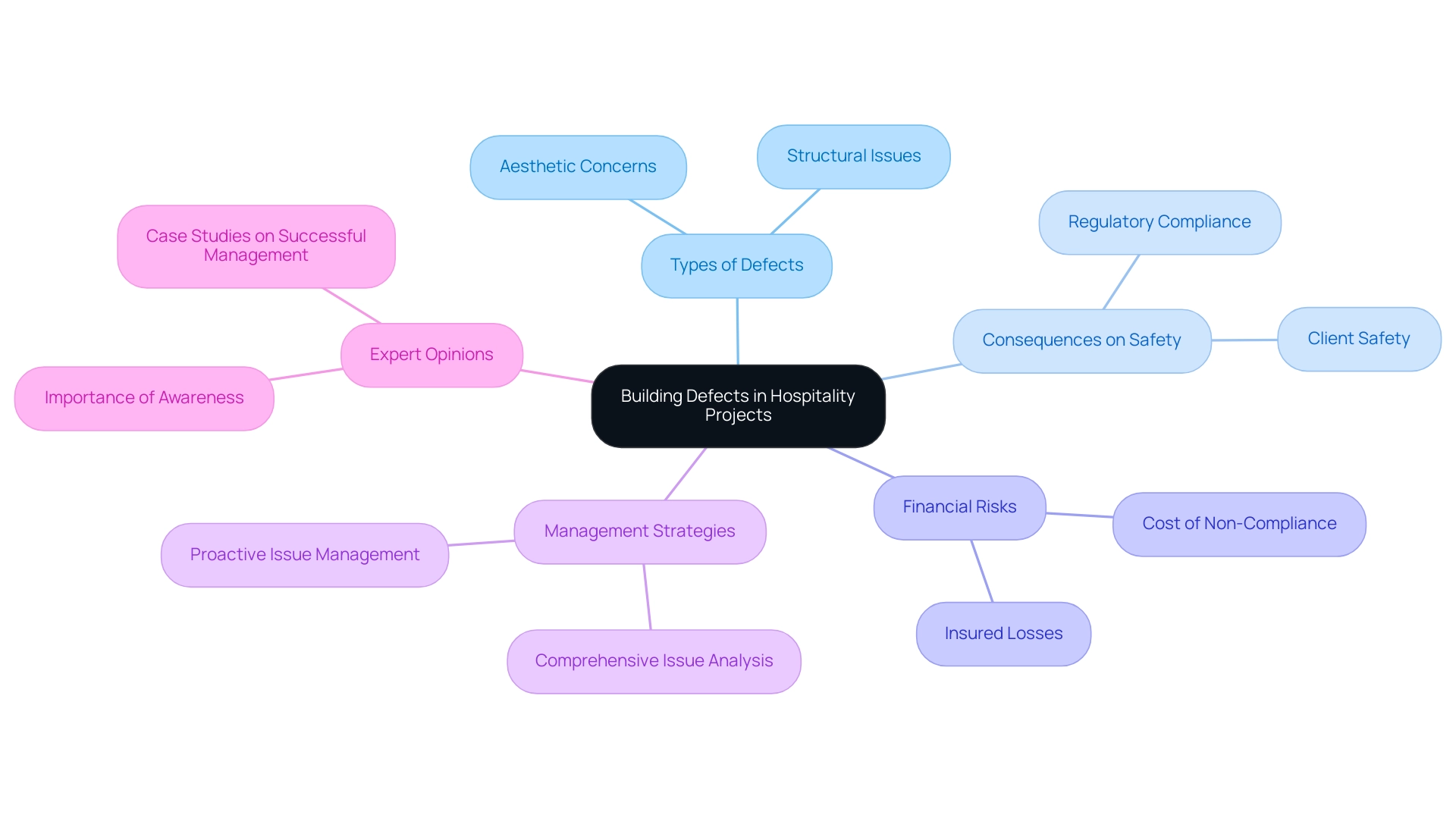
Common Types of Building Defects in Hospitality Developments
In hospitality projects, various categories of construction issues can significantly impact both safety and operational efficiency. Understanding these shortcomings is crucial for developers aiming to uphold high standards and ensure guest satisfaction.
- Structural Issues: Problems with load-bearing walls, foundations, or beams can jeopardise the overall stability of the building. Such flaws not only pose safety risks but can also lead to costly repairs if not addressed promptly. Edmond Shipway’s commitment to innovative practices and continuous improvement is vital in identifying and resolving these structural issues effectively through tailored consultancy services focused on project management and cost efficiency.
- Water Intrusion: This defect manifests as leaks from roofs, windows, or plumbing systems, potentially resulting in mould growth and structural damage. The prevalence of water intrusion has become increasingly concerning, with recent reports indicating that building defects are prompting remediation efforts for numerous affected structures. Notably, since the end of March 2023, 121 additional buildings have submitted applications for funding in the Building Safety Fund, underscoring the industry’s focus on addressing these critical issues. Edmond Shipway provides expertise in assessing and mitigating water intrusion risks, ensuring development projects remain safe and welcoming.
- Finishing Defects: Issues related to paint, flooring, or fixtures can detract from a property’s aesthetic appeal. While these defects may appear minor, they can significantly influence guest perceptions and overall satisfaction. Edmond Shipway’s consultancy services incorporate quality assurance measures that help maintain high finishing standards in service industry projects.
- Electrical and Plumbing Issues: Faulty wiring or plumbing can pose serious safety hazards and disrupt daily operations. Ensuring these systems comply with codes is essential for the smooth functioning of hospitality facilities. Edmond Shipway offers comprehensive evaluations and recommendations to ensure adherence to safety standards.
Identifying these issues early is crucial, as it can lead to substantial savings in time and repair costs. A recent scoping study identified 36 relevant articles on construction issues, emphasising the importance of ongoing research and awareness in the industry. Furthermore, data indicates that a significant number of service industry initiatives encounter building defects, highlighting the necessity for meticulous oversight and proactive administration.
Insights from construction experts reveal that addressing these typical issues not only enhances the safety and durability of accommodation projects but also fosters a more favourable guest experience.

Causes of Building Defects: Insights for Hospitality Developers
Building defects in hospitality construction can arise from a variety of factors, each contributing to potential issues that may affect the integrity and safety of the project. Key causes include:
- Poor Workmanship: A significant contributor to building defects, inadequate skills or insufficient supervision during construction can lead to serious structural problems. Recent reports indicate that 148 structures underwent 151 inspections, highlighting the prevalence of workmanship-related issues in the industry. This statistic underscores the critical need for improved oversight and training in construction practices.
- Building Defects: Incomplete or incorrect designs can lead to building defects, resulting in structural deficiencies or non-compliance with regulatory standards. The importance of thorough design reviews cannot be overstated, as they serve as the foundation for successful project execution.
- Material Quality: The use of substandard materials can result in building defects that severely compromise the durability and safety of a structure. Ensuring that all materials meet industry standards is crucial for preventing building defects that could arise from material failure.
- Environmental Factors: Weather conditions during construction can significantly impact material performance and installation quality. For instance, extreme temperatures or moisture can affect the curing of concrete or the adhesion of finishes, leading to long-term issues.
Understanding these causes allows developers to implement proactive measures to mitigate risks associated with building defects. For example, the UK government’s ‘Get Britain Building Again Programme’ aims to streamline planning processes and prioritise quality in construction, addressing labour shortages and enhancing the overall building environment. This initiative is particularly relevant for developers in the service industry, as it emphasises the importance of quality and efficiency in construction practices.
The construction industry is set for another year of major change, with some significant pieces of legislation coming into effect and legislation already in effect starting to have an impact in practice. This evolving landscape highlights the need for developers to stay informed and adapt to new regulations and standards.
By concentrating on these essential aspects, hospitality developers can minimise the chances of building defects and ensure the successful completion of their endeavours. Edmond Shipway’s extensive experience in managing projects, as demonstrated in their case studies, showcases their commitment to innovative practices and strong client relationships. For example, in one initiative, Edmond Shipway enacted stringent quality assurance practices that greatly diminished flaws, showcasing their efficient strategies in management.
Their knowledge in the service, sport, and leisure fields positions Edmond Shipway as a reliable ally in managing these challenges, ensuring that initiatives are carried out effectively and sustainably.
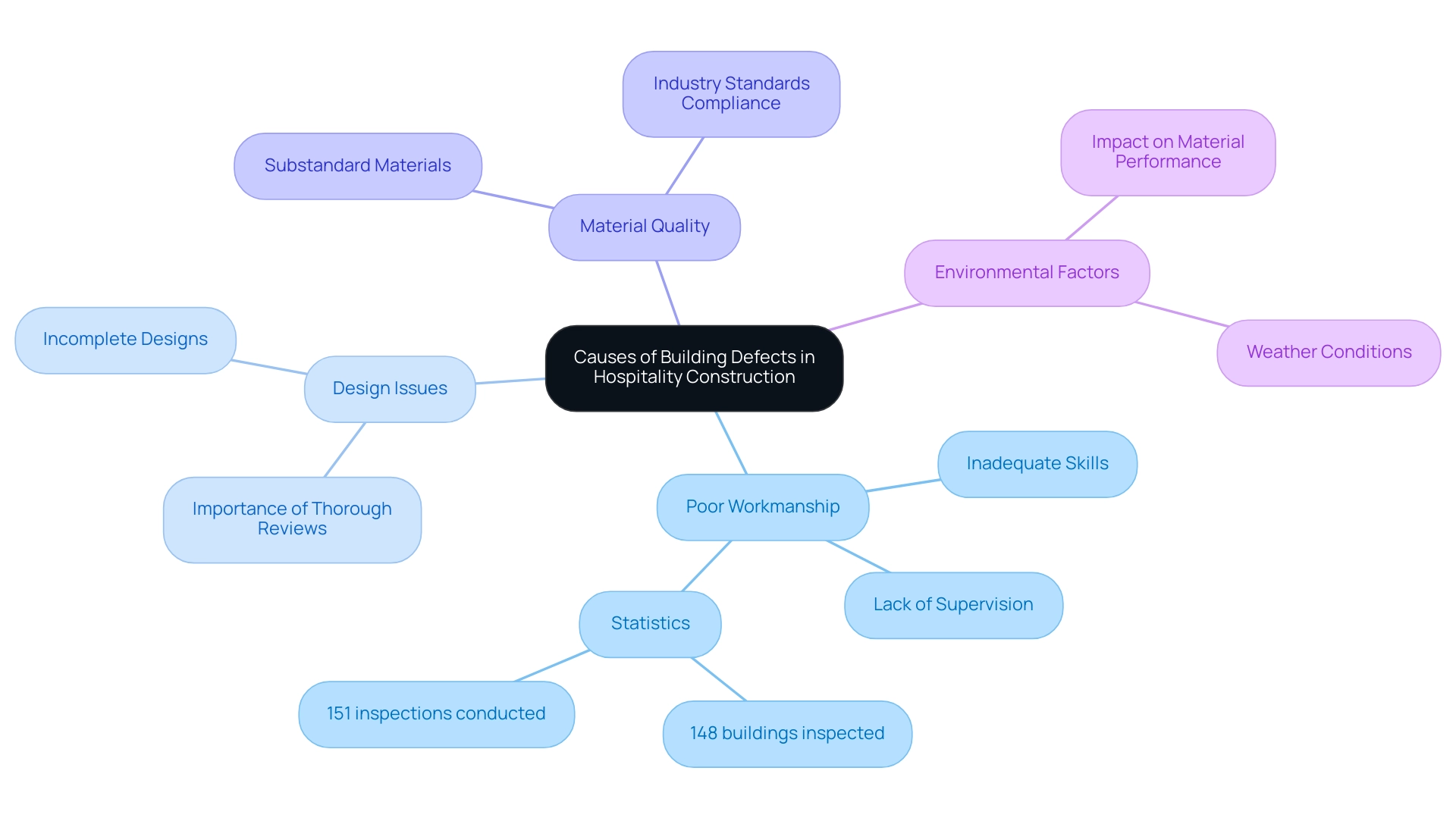
Impact of Building Defects on Project Timelines and Budgets
Construction issues can significantly impact timelines and finances in the industry, manifesting in various crucial forms:
- Delays: The process of identifying and rectifying issues can lead to substantial construction stoppages, extending timelines. In 2025, statistics reveal that nearly 30% of service industry initiatives experienced delays linked to construction problems, underscoring the importance of thorough inspections and proactive management.
- Increased Costs: Addressing these issues often necessitates additional labour and materials, which can inflate the overall budget. Typically, accommodation initiatives in 2025 encountered cost increases of around 15% due to unforeseen building defects. This financial strain can jeopardise the projects’s viability and profitability, especially in light of the recent 4% rise in construction wages as of July 2024, which further burdens budgets.
- Reputation Damage: Persistent issues not only affect immediate outcomes but can also tarnish the reputation of the hospitality brand. A compromised reputation can lead to lost business opportunities and diminished customer trust, particularly detrimental in a competitive market.
Developers must carefully consider these potential impacts during planning and budgeting. By integrating comprehensive issue analysis and reporting into their processes, they can mitigate risks and enhance results. Case studies illustrate that firms with robust flaw management strategies, such as those exemplified by Edmond Shipway’s vast experience in cost consultancy, significantly reduce the likelihood of budget overruns and delays, highlighting the necessity of prioritising quality and thoroughness in construction practices.
Edmond Shipway offers tailored consultancy services focused on proactive flaw management, ensuring that potential issues are identified and resolved early in the lifecycle. This approach not only aids in maintaining timelines and budgets but also elevates the overall quality of construction. Expert commentary emphasises that addressing building defects early in the construction development lifecycle is crucial.
The financial repercussions of neglecting these issues can be severe, resulting in cascading effects that compromise both timelines and budgets. Given the Labour government’s initiatives to boost housing developments, the emphasis on quality construction becomes even more critical, as it directly influences the success of new ventures and the overall health of the service industry.
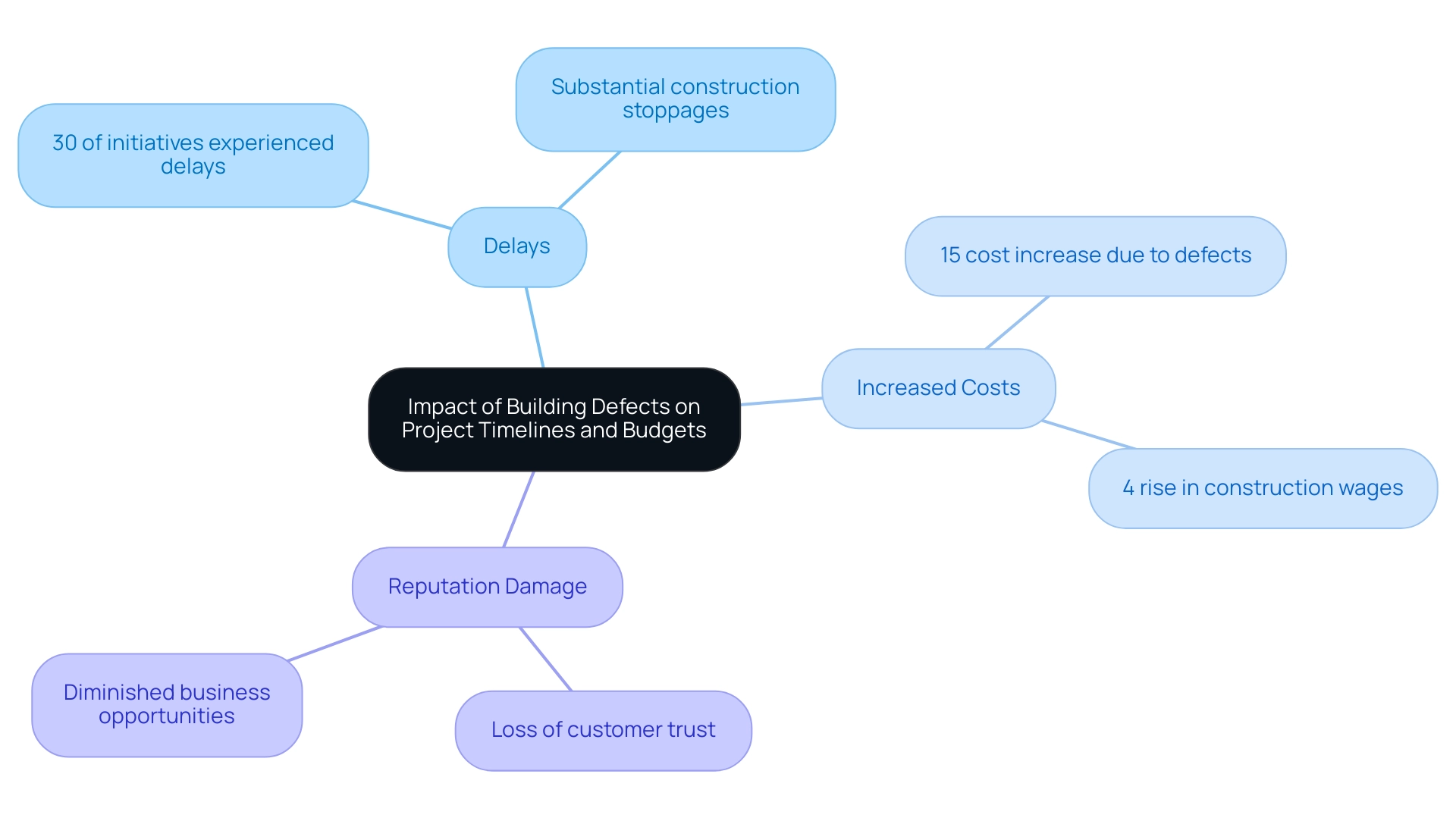
Identifying Building Defects
To effectively recognise structural issues in hospitality initiatives, it is imperative to adhere to the following comprehensive steps:
- Conduct Regular Inspections: Schedule inspections at critical stages throughout the construction process. This proactive strategy enables the early identification of issues, minimising potential long-term effects on project quality and safety. Research indicates that structures undergoing regular evaluations are 30% more likely to have issues detected early, significantly decreasing the frequency of problems and related expenses.
- Utilise Checklists: Develop detailed checklists that specify areas requiring inspection. Focus on key components such as structural integrity, finishes, and mechanical systems. This systematic method ensures that no aspect is overlooked during evaluations.
- Engage Qualified Inspectors: Employ experienced professionals who specialise in building inspections. Their expertise is invaluable in conducting thorough assessments and providing informed opinions on potential issues, ensuring compliance with industry standards.
- Document Findings: Maintain meticulous records of all identified issues. Include photographs and detailed descriptions to create a comprehensive log that can be referenced throughout the remediation process. This documentation is crucial for accountability and future inspections.
- Communicate with Contractors: Foster open communication channels with contractors. Quickly resolve any issues or shortcomings identified during evaluations to enable prompt solutions and sustain progress.
Regular assessments are crucial in the construction sector, as demonstrated by the advancements achieved through initiatives, which has witnessed 64% of structures moving forward with remediation efforts. This emphasises the significance of proactive actions in tackling structural issues. Furthermore, an overview of remediation progress across government programmes addressing unsafe cladding underscores the necessity for thorough inspections. By applying these best practices, developers in the service industry can enhance the quality and safety of their endeavours, ultimately contributing to a more sustainable and successful construction environment.
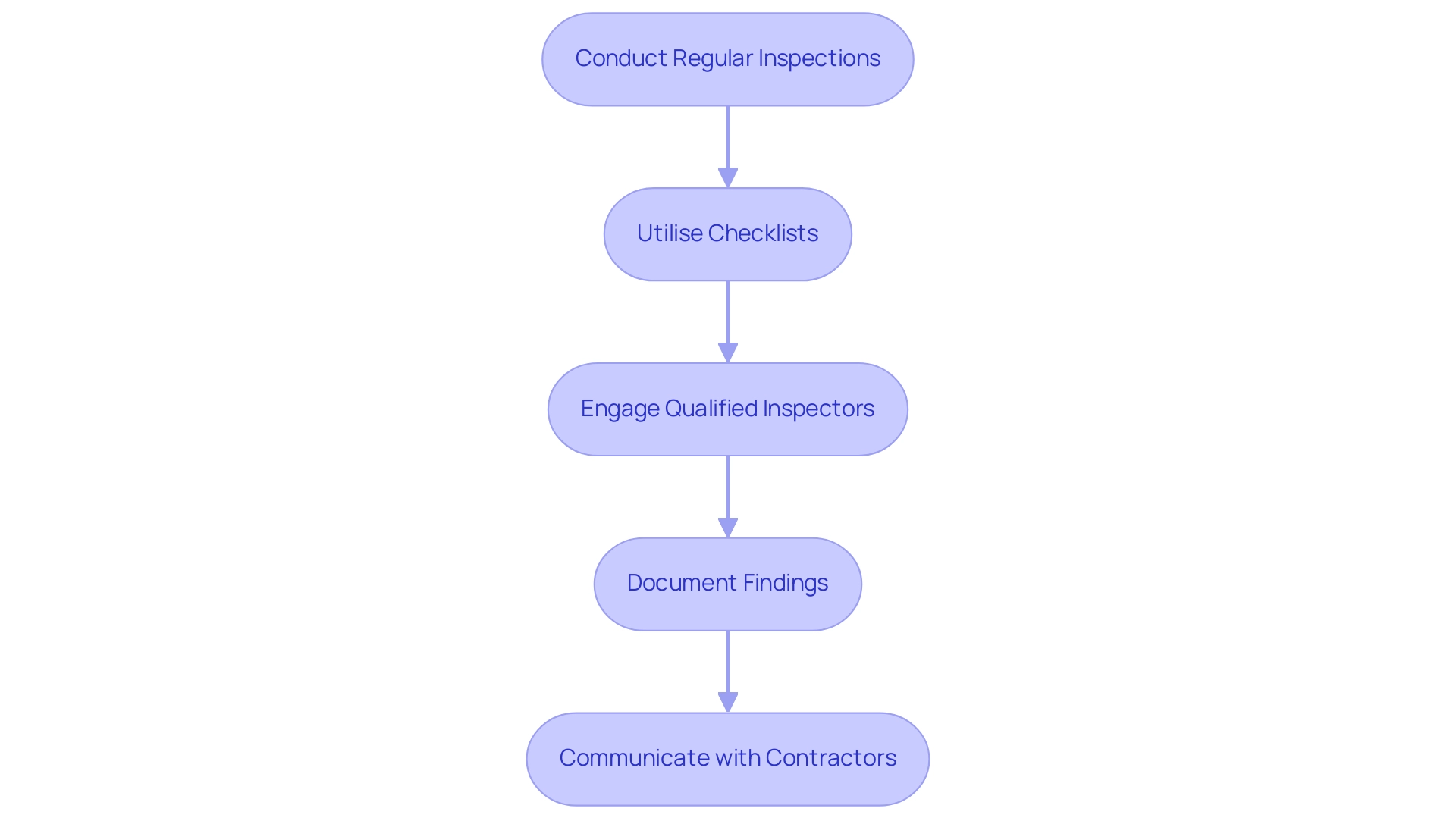
Effective Strategies for Addressing Building Defects
To effectively tackle building defects in hospitality projects, adopting a structured approach that encompasses key strategies is essential.
- Prioritise Repairs: Assessing the severity of defects is the first step. Prioritising repairs based on their potential impact on safety and functionality is crucial in preventing building defects. For instance, addressing structural issues or safety hazards should take precedence over cosmetic repairs, ensuring that the most critical concerns are resolved first.
- Implement Quality Control Measures: Establishing rigorous quality control protocols is vital to prevent future issues. This includes regular inspections and adherence to industry standards throughout the construction process. By integrating quality assurance practices, initiatives can significantly reduce the likelihood of building defects arising post-completion.
- Collaborate with Contractors: Close collaboration with contractors is essential for ensuring that repairs are executed correctly and efficiently. Engaging in open communication and setting clear expectations can lead to better outcomes and adherence to timelines. This partnership is especially crucial in hospitality endeavors, where guest safety and satisfaction are paramount.
- Monitor Progress: Regularly monitoring the status of repairs is necessary to ensure they are completed on time and meet the required standards. Edmond Shipway’s project monitoring services emphasise the importance of this proactive approach, which not only helps in identifying any delays or issues early on but also reinforces accountability among all parties involved. Specific strategies involve thorough monitoring of repair schedules and quality evaluations to reduce risks related to building defects.
In 2025, the construction industry is witnessing a significant focus on quality control measures, with housing providers in England reportedly spending record amounts on repairs and maintenance. This trend highlights the significance of prioritising repairs for structural issues and building defects, especially in the service industry, where the consequences of problems can directly influence guest experiences and operational efficiency. The government’s pledge of £5.1 billion to tackle unsafe cladding on residential structures further underscores the financial need to prioritise repairs, highlighting the potential hazards and expenses linked to ignoring building defects.
Moreover, case studies highlight the necessity of understanding compliance requirements for commercial properties. By following established safety and quality standards, property developers can ensure that their endeavours align with legal regulations, ultimately enhancing the longevity and safety of accommodation facilities. The construction sector is on track for growth from 2025, fuelled by a combination of improved consumer confidence, increased household spending, and strategic fiscal changes announced in the recent Budget.
This emphasises the significance of tackling structural issues as a vital requirement in today’s construction environment.

The Role of Maintenance and Inspections in Preventing Future Defects
Ongoing maintenance and regular inspections are crucial in preventing future defects, especially within hospitality projects. To effectively address this need, consider implementing the following key strategies:
- Establish a Maintenance Schedule: Create a comprehensive routine maintenance plan that includes systematic inspections of critical infrastructure systems. This proactive approach allows for the early identification of potential building defects, significantly reducing the risk of costly repairs in the future. A well-informed team can greatly enhance the effectiveness of your maintenance strategy.
- Utilise Technology: Harness technology solutions to monitor maintenance tasks and inspections. By implementing a robust system, you ensure that no aspect of maintenance is overlooked, facilitating timely interventions and improving overall efficiency.
- Review and Adjust: Regularly evaluate maintenance practices and make necessary adjustments based on insights gained from inspections. This iterative process not only improves the effectiveness of your maintenance strategy but also aligns it with evolving construction standards and regulations. The importance of these practices is highlighted by recent findings indicating that 64% of structures applying for funding in the Safety Fund have initiated or completed remediation efforts. This statistic underscores the critical role of proactive maintenance and inspections in ensuring compliance and safety.
Moreover, case studies demonstrate that local authorities have taken enforcement actions against 532 structures with unsafe cladding, underscoring the essential need for regular inspections and proactive maintenance. As of February 2025, at least 185 improvement notices and 54 hazard awareness notices have been issued, reflecting the ongoing regulatory scrutiny in the construction sector. By prioritising continuous upkeep and evaluations, developers in the accommodation sector can effectively mitigate risks associated with structural issues, ensuring a secure and inviting atmosphere for visitors.
Navigating Regulatory Compliance for Building Defects
Navigating regulatory compliance for building defects is a crucial element of successful hospitality ventures. To ensure adherence to local regulations, consider the following key strategies:
- Understanding Local Regulations: Familiarising yourself with the specific building codes and regulations governing construction practices in your area is essential. Each locality may have unique requirements that can significantly impact project execution. For instance, the expansion of Low Emission Zones (LEZs) across eight cities in England and four in Scotland has introduced new compliance challenges that developers in the service industry must navigate. Edmond Shipway’s multi-sector expertise enables us to provide insights not only in hospitality but also in sectors like healthcare and finance, ensuring a comprehensive understanding of diverse regulatory landscapes.
- Documentation: Maintaining comprehensive documentation is vital. This includes records of all inspections, repairs, and compliance efforts. Thorough documentation not only demonstrates adherence to regulations but also serves as a valuable resource in case of disputes or audits. The recent technical note on Building Safety Remediation, released in January 2025, emphasises the importance of accurate records in ensuring compliance with safety standards. Edmond Shipway offers tailored consultancy solutions to help clients establish effective documentation practices that meet regulatory requirements across various sectors.
- Engage Legal Experts: Consulting with legal professionals specialising in construction law can provide invaluable insights into navigating the complexities of local regulations. Their expertise can help ensure that all aspects of your endeavour comply with relevant laws and standards, reducing the risk of costly delays or penalties. Edmond Shipway collaborates with legal experts to offer clients comprehensive support in understanding and implementing compliance strategies.
- Stay Updated: The regulatory landscape is constantly evolving, making it crucial to stay informed about changes that may influence your initiatives. Regularly reviewing updates from local authorities and industry bodies can help you anticipate and adapt to new compliance requirements. Our team at Edmond Shipway continuously monitors regulatory changes across sectors, providing clients with timely updates and actionable insights.
In addition to these strategies, case studies highlight the importance of proactive compliance measures. For example, the Enhanced Remediation Enforcement initiative proposes increased funding and enforcement powers for local authorities, aimed at ensuring compliance with construction safety regulations. Such initiatives underscore the need for developers to remain vigilant and responsive to regulatory changes.
A recent case study from our work in the healthcare sector illustrates how proactive compliance measures led to successful outcomes, which can be applied to service industry initiatives as well.
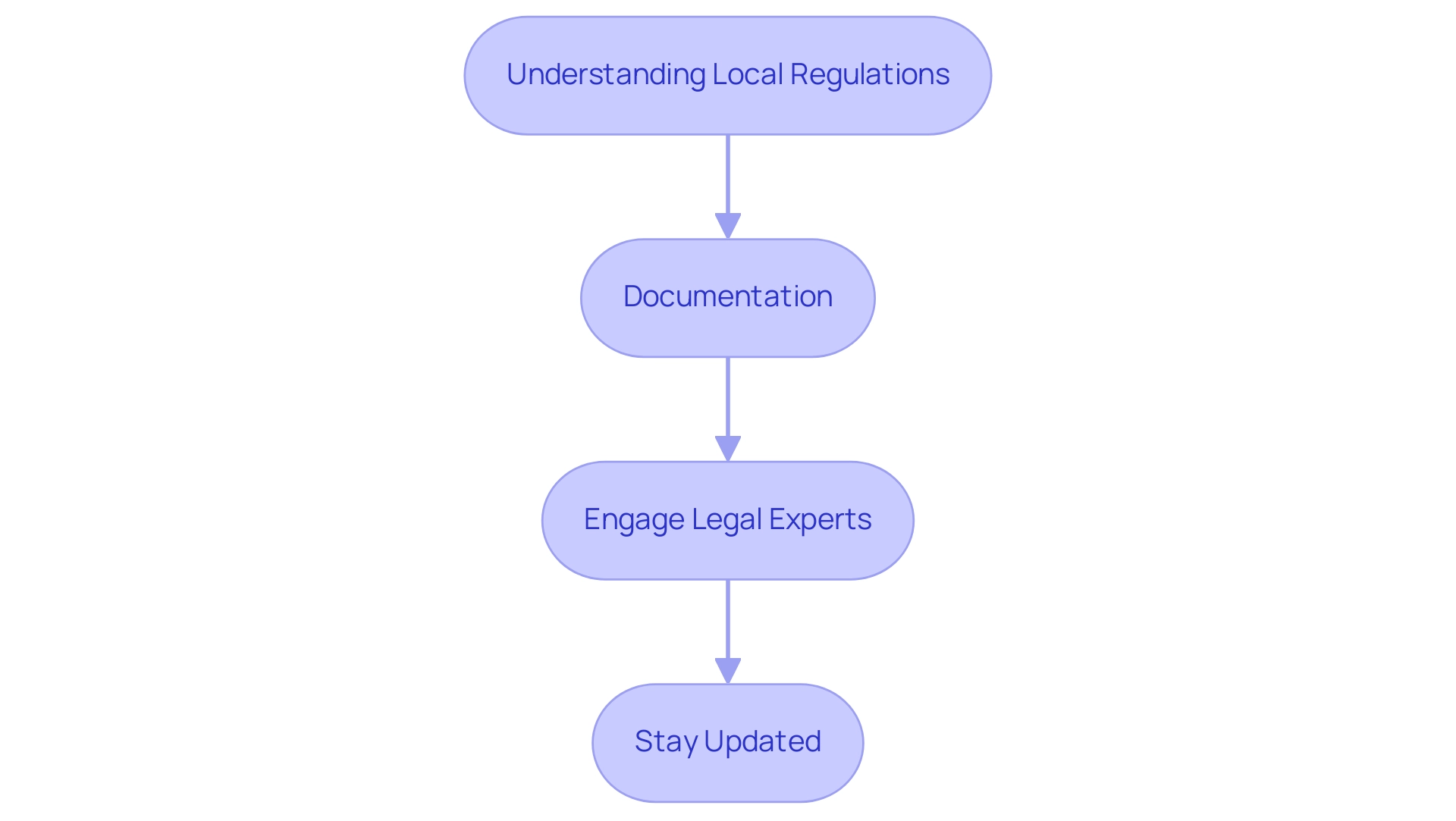
Collaboration and Communication: Key to Managing Building Defects
Effective collaboration and communication are paramount in managing building defects, particularly within hospitality endeavours. To ensure success, consider implementing the following strategies:
- Establish Clear Channels: Develop well-defined communication pathways among all stakeholders, including contractors, inspectors, and project managers. This clarity helps prevent misunderstandings and ensures that everyone is aligned on objectives.
- Regular Meetings: Schedule consistent meetings to review project progress, identify potential issues, and devise strategies for resolution. These gatherings encourage a proactive approach to issue management, allowing teams to address problems before they escalate.
- Encourage Feedback: Create an open environment where team members feel empowered to share feedback and voice concerns regarding issues. This culture of transparency can lead to early detection of issues and collaborative problem-solving.
- Document Communication: Maintain thorough records of all communications related to defects. This practice not only ensures accountability but also provides a reference point for future discussions and decisions.
Research indicates that effective communication significantly enhances outcomes, with informal communication positively impacting success. In 2025, statistics indicate that enhanced communication techniques have resulted in a significant reduction in disagreements associated with construction issues in service industry endeavours, highlighting an increasing awareness of the value of teamwork among contributors.
Furthermore, a recent case study highlighted a decrease in the percentage of respondents citing a lack of competence from participants as a cause of disputes, dropping from 48% to 42%. This trend suggests that enhanced training and resources are leading to better contract management practices and fewer disputes.
By prioritising these communication strategies, stakeholders can effectively manage building defects, ultimately leading to greater satisfaction and success in service industry endeavours.
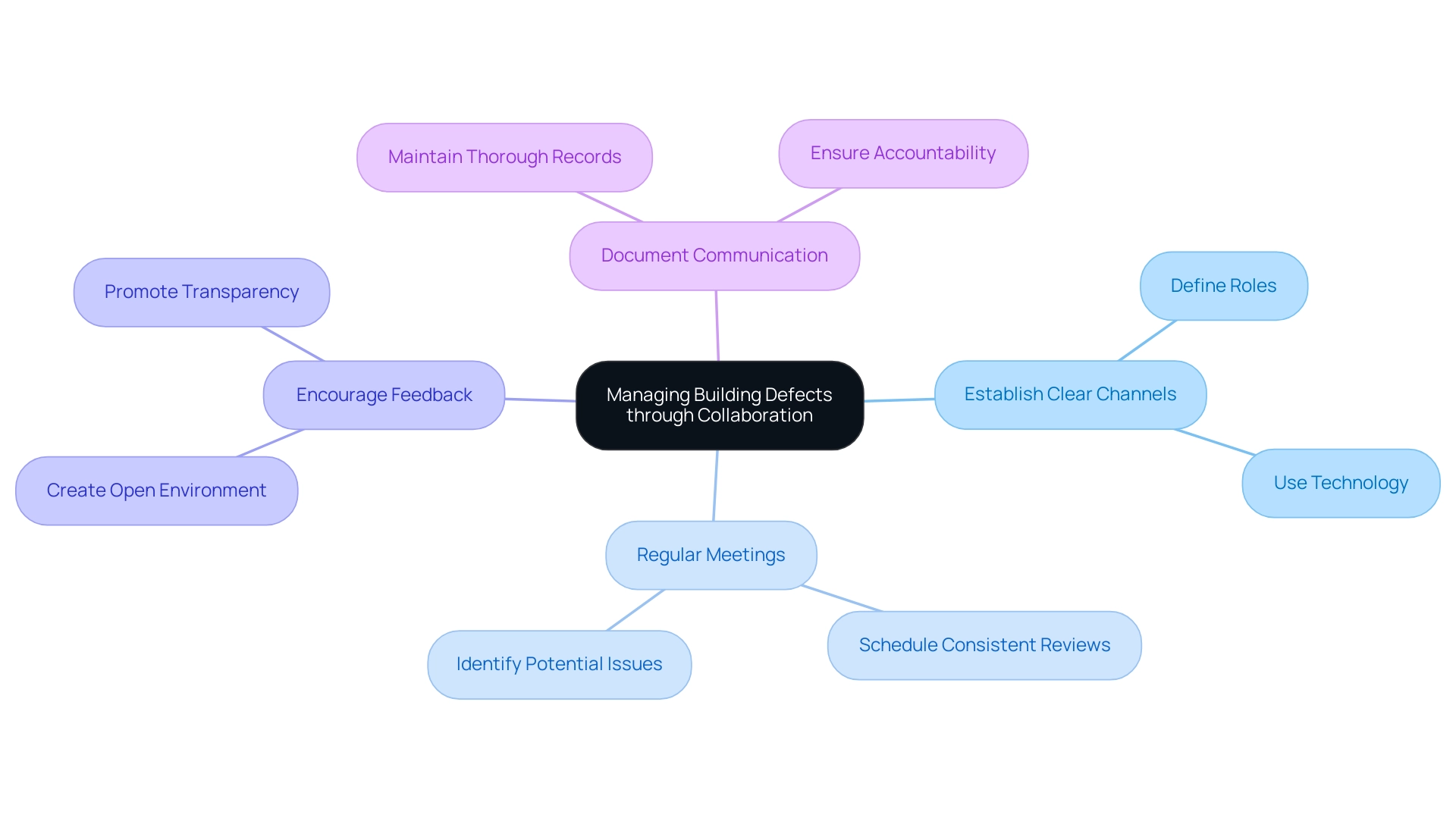
Conclusion
Building defects pose substantial challenges for hospitality developers, impacting not only the safety and integrity of projects but also their financial viability and reputation. Recognising the various types of defects—ranging from structural issues to water intrusion, finishing defects, and electrical problems—underscores the urgent need for proactive management. By identifying root causes, such as poor workmanship, design flaws, and material quality, developers can implement effective strategies to mitigate risks and enhance project outcomes.
The financial ramifications of building defects are significant. Delays and increased costs associated with rectifying these issues can jeopardise project success, particularly in a competitive market where guest satisfaction is paramount. Therefore, prioritising thorough inspections, robust quality control measures, and effective communication among stakeholders is essential. Engaging qualified professionals and maintaining meticulous documentation further solidifies compliance with local regulations and safety standards.
Ultimately, addressing building defects is not merely a regulatory obligation; it is a strategic imperative that fosters trust, enhances operational efficiency, and ensures long-term success in hospitality projects. By embracing a culture of continuous improvement and proactive defect management, developers can safeguard their investments, uphold safety standards, and deliver exceptional experiences for guests, paving the way for a thriving hospitality sector.
Share


